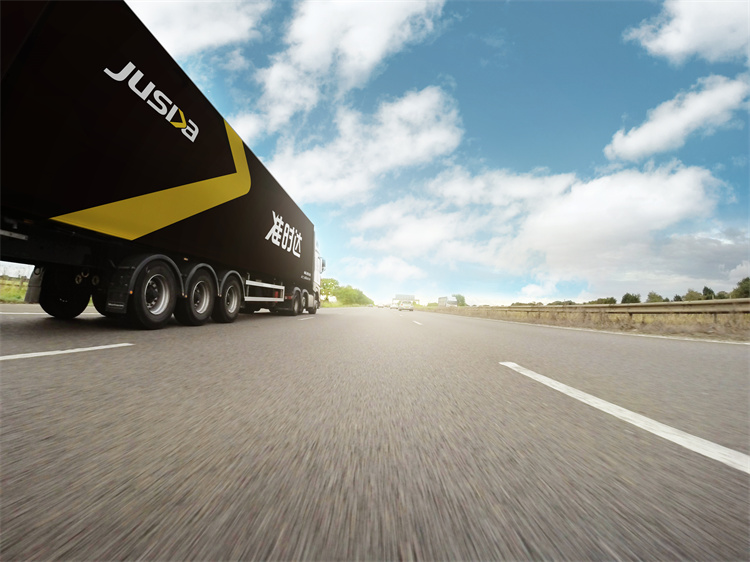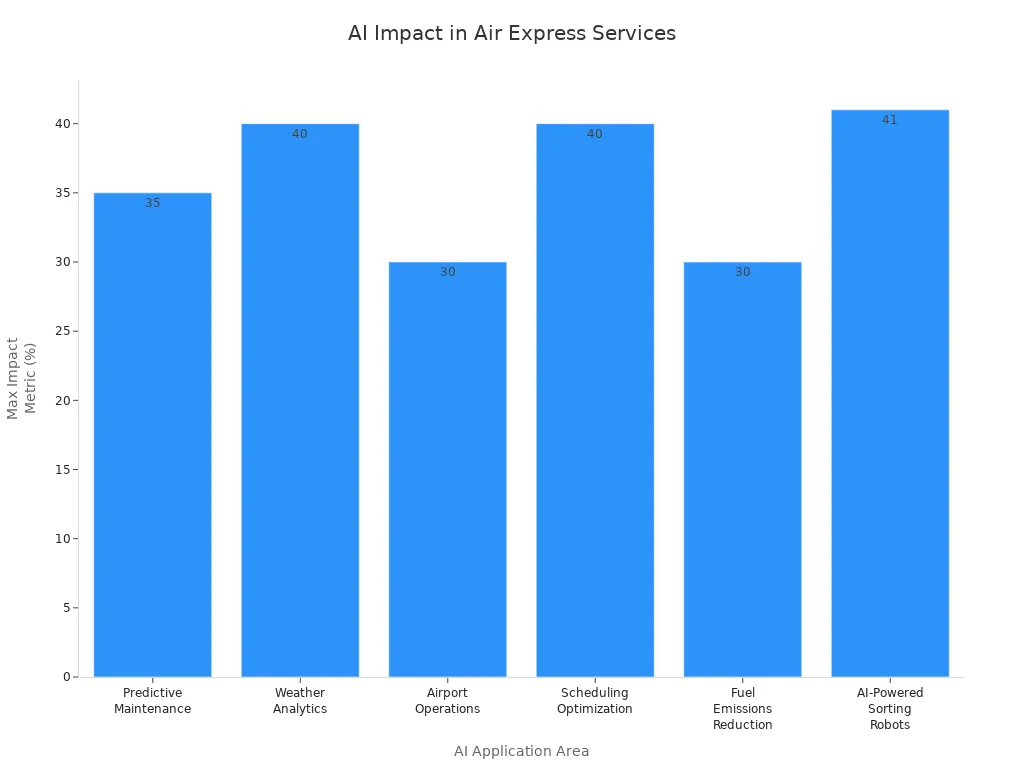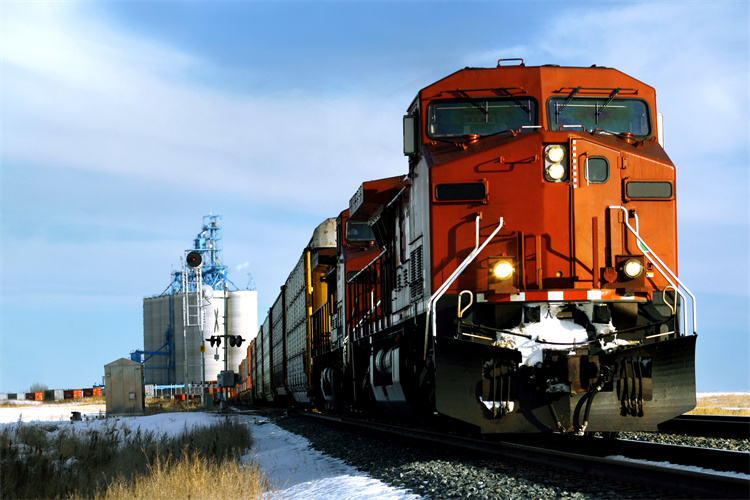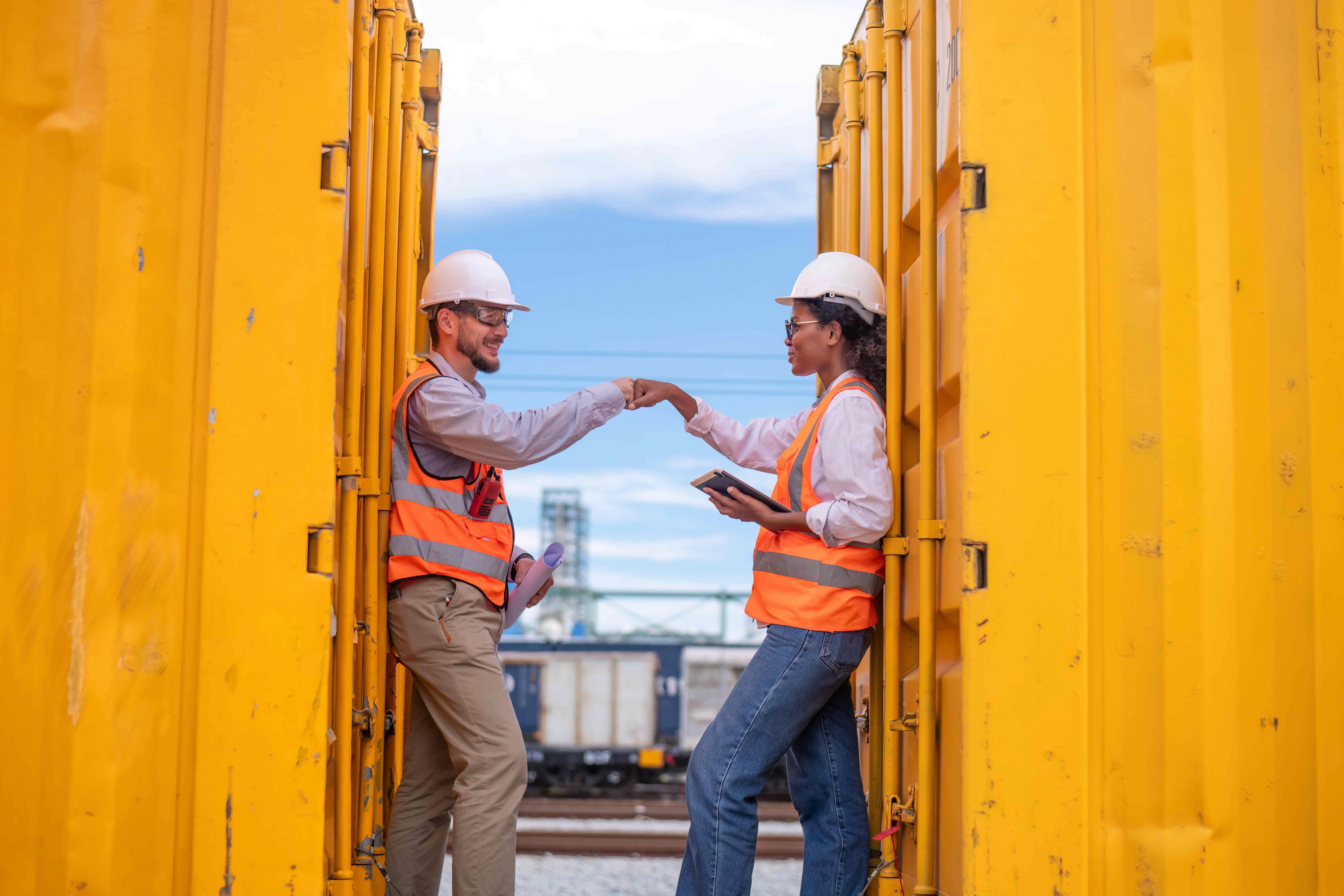How AI and Automation Are Shaping Air Express Logistics

AI and automation change air express services in 2025. Companies use smart systems to plan routes and run warehouses. These systems help meet the need for fast and correct service. Real-time tracking helps people trust the service. Smart energy use and electric vehicles help the planet. Using digital tools gives companies a big advantage.
Key Takeaways
AI and automation make air express logistics faster. They help with route planning, package tracking, and warehouse work. This means deliveries are quicker and more reliable.
Smart tools like predictive analytics and real-time tracking help companies save money. They also help avoid problems and keep customers happy. These tools manage risks and inventory better.
Using robotics, IoT, and green technologies makes logistics safer. It also makes them work better and helps the environment. This helps companies handle more packages and meet green goals.
AI in Air Express Services

Artificial intelligence is making air express services smarter and faster. Companies use special tools to guess what customers will need. These tools also help manage risks and keep packages moving. JUSDA’s JusLink AI Solution is a leader in this area. It has features like supply chain trend analysis, demand forecasting, and risk management. These tools help businesses stop problems before they happen. They also help deliver packages more quickly.
Process Optimization
AI helps air express services work better by improving many steps. Companies use AI to plan routes and manage fleets. AI also helps keep planes in good condition. The table below shows how AI makes things run smoother and more reliably:
AI Application Area | Description | Impact Metrics / Benefits |
|---|---|---|
Predictive Maintenance | AI and IoT watch over aircraft health to fix problems early, so planes don’t sit unused. | Maintenance costs drop by 20-35%, planes last 15-25% longer |
Weather Analytics | AI models help predict bad weather for safer flights. | Accuracy up by 40%, better at finding severe weather by 20-40% |
Airport Operations | AI systems help passengers move faster and flights leave on time. | Wait times down by 15-30%, more flights leave on time by 25% |
Scheduling Optimization | Smart algorithms help with crew schedules and using planes well. | Fleet use up by 15-25%, flights on time up by 20-40% |
Fuel Emissions Reduction | AI finds the best flight paths and engine settings to save fuel. | Fuel use down by 10-30%, carbon emissions down by 25% |
Runway Assignments | Machine learning helps pick runways to cut delays and work better. | Smoother operations, fewer runway delays, better experience |
AI robots sort packages quickly and make fewer mistakes. | Sorts 1000+ parcels/hour, 41% more efficient | |
AI-Powered Logistics Platforms | AI helps pick the best routes and track shipments in real time. | Better route planning and tracking |

JUSDA’s JusLink AI Solution uses these tools to help companies avoid problems. It also helps them keep up with new technology and ways of working. For example, Sharp, a big home appliance company, worked with JUSDA to make its supply chain better. By using AI, Sharp lowered logistics costs by 20%. It also cut labor costs by 70% and made deliveries 30% faster. This real example shows how AI can make air express services much better.
Predictive Analytics
Predictive analytics uses data to help air express services plan ahead. AI looks at old sales, market trends, and other things to guess what people will want. This helps companies keep the right amount of stock and avoid running out or having too much. When companies know what to expect, they can deliver faster and avoid problems.
Predictive analytics helps companies:
Guess what customers will want and keep enough stock.
Save money by not having too much or too little.
Find risks like theft, damage, or delays before they happen.
Make better choices and keep customers happy.
JUSDA’s JusLink AI Solution uses predictive analytics to help companies react fast to changes. For example, it can guess market trends and changes in space up to a week early. This helps companies plan shipments and workers better, saving money and making deliveries on time. Sharp used these tools to make its work easier, showing how predictive analytics can really help air express services.
Smart Tracking
Smart tracking lets companies and customers see where packages are all the time. Technologies like GPS, IoT sensors, RFID, and AI work together for real-time tracking and quick updates. This helps companies fix problems fast and keep deliveries on time.
Technology | How it Enables Smart Tracking and Improves Shipment Visibility |
|---|---|
IoT | Gives real-time updates, checks conditions, and tracks items for accuracy. |
Computer Vision | Makes more data and helps automate for better transparency and efficiency. |
AI | Helps with smart analysis, predictions, and automating decisions. |
GPS | Tracks packages with location updates, keeping things on time and safe. |
Sensors | Watch for temperature, humidity, and shocks, sending alerts if needed. |
RFID | Helps manage inventory and security with fast scanning and real-time data. |
Edge Computing | Makes decisions faster at the warehouse or shipment level. |
Smart Locks/Labels | Keeps shipments safe and labels items automatically to avoid mistakes. |
Smart tracking also helps with fast delivery by changing routes quickly if needed. Companies using these systems lose fewer packages, spend less, and have happier customers. JUSDA’s JusLink platform uses these tools to give real-time tracking and help clients avoid costly problems.
Automated Handling
Automated handling uses robots and smart machines to move, sort, and load packages. These systems make things go faster, need less human work, and lower mistakes. For example, AI-powered sorting robots can handle over 1,000 parcels per hour, making things 41% more efficient.
Automated handling brings many benefits:
Orders get processed faster and turnaround times are shorter.
Labor costs go down and there are fewer mistakes.
Resources are used better and workers are safer.
Fast delivery is more reliable, even when it’s busy.
JUSDA’s JusLink AI Solution helps with automated handling by linking warehouse, transport, and inventory systems. This helps companies fix problems quickly and keep packages moving. The Sharp example shows how automation can save money and speed up deliveries, making air express services stronger.
Automation and Logistics Trends 2025

Robotics in Warehousing
Robotics are very important for logistics in 2025. Companies use automated guided vehicles to move goods fast. Robotic palletizers and automated picking systems help too. These robots pick, pack, and sort items. This makes air freight work better. Many warehouses now use automated storage and retrieval systems. These systems save space and help stop mistakes. Robots work with people to make jobs safer. They also make work less tiring for workers. This teamwork helps workers do more each year. Labor productivity can go up by 37%. Big companies like Amazon and DHL spend a lot on robotics. They want to handle more packages and do it faster. JUSDA uses cloud warehousing and smart robots. This helps clients move more air freight with fewer errors.
Main benefits of robotics in air freight:
Orders get filled faster
Fewer mistakes when picking items
Lower costs for workers
Warehouses use space better
IoT and Real-Time Data
IoT technology changes logistics by giving real-time data. GPS trackers show where air freight is all the time. RFID tags and smart sensors check temperature and humidity. They also watch for shocks to keep goods safe. Telematics systems track vehicles and help plan routes. Smart pallets and containers help stop loss and theft. These tools help companies keep air freight moving well. JUSDA’s platforms use IoT to give instant updates and alerts. This makes it easier to manage shipments and avoid delays.
Note: IoT devices also help with predictive maintenance. This keeps vehicles and equipment working well for air freight.
Multimodal Hubs
Multimodal hubs link air, rail, sea, and road transport. Automation in these hubs makes sorting faster. It also helps stop mistakes from people. AI-driven route planning and IoT tracking help switch between transport types. This makes it easy to change plans when needed. Real-time data from sensors and tracking shows where air freight is at each step. JUSDA’s cloud solutions support these new trends. They help clients grow without spending more money. These trends make air freight more reliable and efficient for everyone.
Air Freight Market Trends
Capacity and Demand
The air freight market is growing in 2025. Experts say it will grow by about 4.9% each year until 2033. More people shop online and want fast shipping. This makes more companies use air freight. But there is not enough space for all the packages. Space is only growing by 4-5%. This means there is a tight balance between how much space there is and how much is needed. Fewer passenger flights mean less room for cargo. This makes it harder to find space for packages. Air freight is very busy on routes from China to Europe and the U.S. Companies work together and combine shipments to solve these problems. JUSDA helps clients by giving good air freight plans and getting ready for busy times.
Pricing Pressures
Air freight prices are changing a lot. There are not enough workers and some routes are different now. Problems at ports make costs go up and down. Carriers change extra fees every week or two. This makes it hard to know what prices will be. The economy and new taxes also make things less certain. Companies use digital tools and AI agents to watch prices and plan shipping. These tools help keep costs steady and handle changes. JUSDA’s JusLink platform lets clients see where their cargo is and what it costs. This helps them deal with price changes.
Sustainability Initiatives
People care more about the environment in air freight. Airlines and logistics companies use sustainable aviation fuel, called SAF, to lower pollution. SAF is made from things like used cooking oil and trash. It can cut greenhouse gases by up to 94%. SAF is expensive and hard to get, but it is important for cleaner air. The air freight industry also buys new planes, uses AI to plan routes, and tries to reuse things. JUSDA leads with green logistics and helps clients meet tough environmental rules.
JUSDA’s Role in the Air Cargo Market
JusLink AI Capabilities
JUSDA is special in the air cargo market because it uses smart digital tools with its JusLink AI platform. This platform uses things like RFID and warehouse management systems. These help companies keep track of inventory and use predictive analytics. JusLink lets companies see everything happening in their supply chain. It collects and studies data right away. This helps businesses make good choices and handle risks fast. The platform works like a smart control tower for air cargo. It connects data, management, and smart computer programs. JusLink uses AI and IoT to help suppliers, makers, and customers work together. With these tools, companies can guess what they will need, manage inventory, and find risks before they get big. Real-time tracking and analytics let users watch every part of their air cargo shipments. This makes work smoother and more dependable.
Customer Success Stories
Many companies in air cargo have gotten real help from JUSDA’s AI-powered tools.
Jack Chang, who leads JUSDA Freight Services, says they can see profits better and pay vendors faster. This keeps trucks ready to go.
JUSDA started using Expedock, so the business could grow without needing more workers.
Pam Berry, who works at Mallory, saw less manual data entry. Hard invoices were handled with almost perfect accuracy.
Sophia Ko, who manages imports at ClearFreight Los Angeles, saved 10-15 hours each week. Her team could spend more time helping customers and doing billing.
During the pandemic, Expedock handled 3,000 invoice lines in one week. This saved JUSDA $500,000 in costs.
Lorenzo Giusti, who runs Alisped, liked Expedock for solving tough problems that others could not fix.
Expedock’s AI did all the work with almost perfect accuracy. This cut down on manual work and helped teams handle special cases better.
The AI also changed shipment data into TMS entries. This made import work easier and faster.
These stories show that JUSDA’s technology makes things more accurate, saves money, and helps companies do better in air cargo.
Overcoming Challenges in Logistics in 2025
Integration and Costs
Companies have some big problems when using new technology in logistics in 2025. The table below lists the main problems and ways to fix them:
Challenge / Cost Factor | Description | Supporting Detail / Statistic |
|---|---|---|
Data Quality and Accessibility | AI needs clean and organized data to work well. | Working with partners helps fix data problems. |
High Implementation Expenses | It costs a lot to start using AI and automation. | In 2023, companies spent $154 billion on AI worldwide. |
Integration with Legacy Systems | Old systems do not always match with new AI tools. | Using cloud and modular systems can help connect them. |
Skilled Talent Shortage | There are not enough people who know AI and data science. | 68% of leaders say it is hard to hire these workers. |
Mitigation Strategies | Companies use cloud, training, and expert help to lower risks. | Taking small steps makes it cheaper and safer. |
Many companies use step-by-step plans and cloud tools to save money and avoid problems. Digital freight booking also makes it easier to connect systems and work faster.
Skills and Training
Workers need to learn new things to keep up with changes in logistics.
Learning new skills helps workers use AI and automation every day.
Training teaches software, data, and how to use drones.
People must learn to work well with AI.
Companies team up with tech partners to find skilled workers.
Teams keep learning so they are ready for new changes.
Cybersecurity
New digital tools bring new dangers. Companies use different ways to stay safe:
Checking for cyber risks helps find weak spots.
Teaching workers stops mistakes that cause hacks.
Special security teams fight new online threats.
Companies watch outside partners and follow new rules like NIS2.
Cyber insurance and good rules help fix things after attacks.
Sustainability
Sustainability is still very important in logistics. Companies use these ideas to help the planet:
Packing smart and loading well cuts pollution.
Sending things back for recycling saves resources.
Using real-time data and AI helps waste less.
Smart inventory stops making too much stuff.
Sharing rides with others means fewer empty trucks.
Planning routes well saves gas.
Green warehouses use solar power and smart cooling.
Electric and other clean vehicles make less pollution.
Using better packaging means less trash.
Carbon offsets help balance out pollution that cannot be stopped.
These ideas help companies follow rules, save money, and earn trust from customers.

JUSDA Solutions
To provide you with professional solutions and quotations.
AI and automation are making big changes in air express logistics. Companies can deliver packages faster and track them better. They also spend less money on shipping. Tools like JUSDA’s JusLink help companies use digital technology to stay ahead. Leaders who buy new technology and train their teams do better than others. They keep getting better and stay ahead of the competition.
See Also
Discovering Hidden Opportunities Of AI Within Logistics
How AI Is Transforming The Future Supply Chain
Enhancing Supply Chain Efficiency Through AI Innovations
